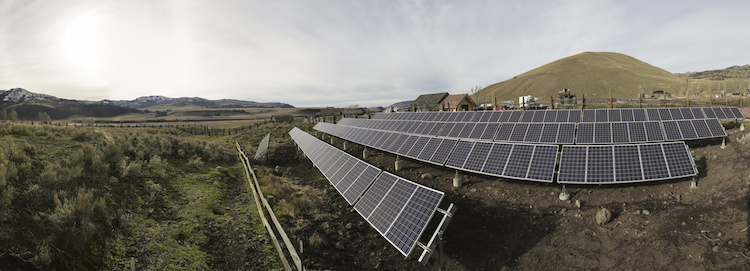Old hybrid batteries have a new home on the range. Toyota has flipped the switch on a project that is reusing 200 old battery packs from Toyota Camry hybirds. The Lamar Buffalo Ranch field campus in Yellowstone National Park, now not only features buffalo, but an innovative distributed energy system that combines solar power generation with re-used Camry Hybrid battery packs. The result according to Toyota: reliable, sustainable, zero emission power to the ranger station and education center for the first time since it was founded in 1907. Solar panels generate the renewable electricity stored within the 208 used Camry Hybrid nickel-metal hydride battery packs, recovered from Toyota dealers across the United States.
Announced in June 2014, the partnership among Toyota, Indy Power Systems, Sharp USA SolarWorld, Patriot Solar, National Park Service and Yellowstone Park Foundation is an innovative effort to extend the useful life of hybrid vehicle batteries while providing sustainable power generation for one of the most remote, pristine areas in the United States.
 “Through our long-standing partnership with Yellowstone National Park and the Yellowstone Park Foundation, Toyota has helped preserve Yellowstone for future generations,” said Jim Lentz, chief executive officer, Toyota North America. “Today, our relationship with Yellowstone continues, as more than 200 battery packs that once powered Toyota Camry hybrids have found a new home on the range.”
“Through our long-standing partnership with Yellowstone National Park and the Yellowstone Park Foundation, Toyota has helped preserve Yellowstone for future generations,” said Jim Lentz, chief executive officer, Toyota North America. “Today, our relationship with Yellowstone continues, as more than 200 battery packs that once powered Toyota Camry hybrids have found a new home on the range.”
On an annual basis, the solar system will generates enough electricity to power six average U.S. households for a year, or plenty of power for the five buildings on the Ranch campus. The hybrid batteries provide 85kWh of energy storage to ensure continuous power, as the system charges and discharges. Onsite micro-hydro turbine systems, capturing energy from a neighboring stream, are scheduled to join the power mix in 2016.
The Yellowstone system is the first of its kind to use recovered hybrid vehicle batteries for commercial energy storage. Each battery pack has been disassembled and tested, and every piece that could be was repurposed. New components were also designed and built by Indy Power Systems specifically for this application, including an onboard battery management system for each battery pack. The battery management system is designed to maximize battery life and will also provide important insights into real-world performance. These insights will help Toyota design future battery performance and durability improvements.
“Toyota’s innovative response to solve a difficult problem has helped Yellowstone move closer to its goal of becoming the greenest park in the world,” added Steve Iobst, acting superintendent of Yellowstone.
 President Rafael Correa of Ecuador has issued a decree that orders the gradual national roll out of a 10pc ethanol blend in gasoline, using a price index published by Argus Americas Biofuels. The country is branding the ethanol-blend “Ecopais” and the goal is aimed at reducing the country’s growing high-octane gas imports that are blended with locally produced low-octane gas to make 87 octane and 92 octane.
President Rafael Correa of Ecuador has issued a decree that orders the gradual national roll out of a 10pc ethanol blend in gasoline, using a price index published by Argus Americas Biofuels. The country is branding the ethanol-blend “Ecopais” and the goal is aimed at reducing the country’s growing high-octane gas imports that are blended with locally produced low-octane gas to make 87 octane and 92 octane.








